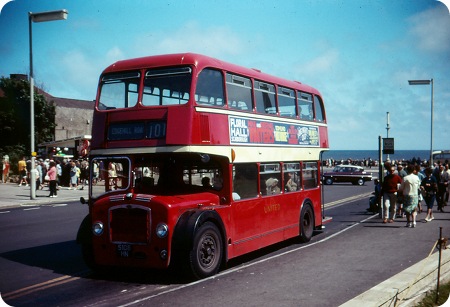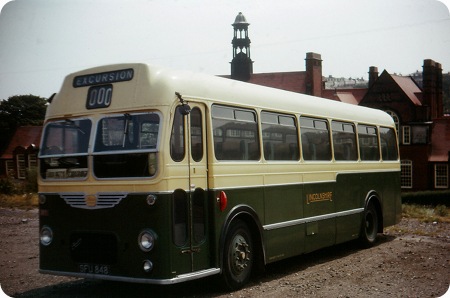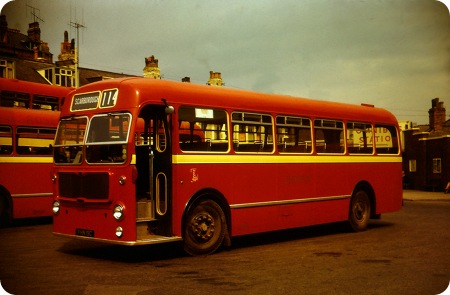United Automobile – Bristol Lodekka FS6B- 5108 HN – L108
United Automobile Services
1962
Bristol Lodekka FS6B
ECW H33/27R
This photo was taken in the middle of July 1966 and is the Scarborough North Bay ‘Corner Cafe’ terminus of several routes. This photo apart from being a nearly decent shot of a ‘Short Lodekka’ is a flash back to when an English seaside resort had every thing going for it, doesn’t it look busy. I do like the Ford Anglia on the roundabout.
In the mornings on the way to our chalet (No 99) I used to buy a pound of pea pods from the fruit and veg shop at the other side of the road from this bus stop and boy did they taste good, nice and sweet, and in the evening on the way back to the our B&B I would have a waffle with cream and raspberry jam from the waffle shop around the corner from this view, those were the days. (Sorry about the over long sentence but got carried away in nostalgia).
A full list of Bristol codes can be seen here.
A full list of United codes can be seen here.
The Bristol FS in the picture is one of a small batch of five delivered in February and March 1962 for use on Scarborough town services only. The FS was a very rare beast in United colours – there were only seven in the entire fleet of around 1,200 buses. The Scarborough vehicles were also unusual – in an age of power-operated jacknife doors and front entrances – in having open rear platforms. I believe an agreement with Scarborough Town Council ensured the buses never strayed from the resort right up until their withdrawal some 14 years later. I also believe the vehicles operated mainly in the summer season and were garaged for half the year, so they must have had fairly low mileages. For this reason, it’s a shame one never made it to preservation. I understand they all disappeared at the end of the 1976 summer season although one example may have stayed on as a driver-trainer until as late as 1978.”
“If anyone has any more information about these buses, or any more pictures, I would be very interested!!!
Dorsetcol
I remember the other two Bristol Lodekka FS6Bs L55/56 both these had rear doors from new I think, they operated out of Darlington on the Stockton 21 or Hartlepool 24 service. The Bishop Auckland route was the preserve of the first Bristol Lodekka LD6Bs L1-5. L56 went to West Yorkshire in exchange for a front entrance model which united was by then operating.
Paul Fraser
When West Yorkshire and United did their swap the ex United bus took the FSFs number in the West Yorkshire fleet DX82. I may be wrong but I think West Yorkshire were the only BTSC fleet to end up with a wholly rear entrance double deck fleet until the advent of the VR in 1969.
Chris Hough
From when I first glimpsed West Yorkshire’s FSF6B DX82 in Bingley as a child, it always remained one of my favourite buses in the fleet. I had never seen a front-entrance double-decker before, so this was something special. Imagine the dismay when WY exchanged it for an ‘ordinary’ FS6B in 1967! Interestingly, the FSF lost its ‘T’ style destination layout on transfer to United for one of their side by side destination/route number display. Unusually, the ex-United FS retained its full three-aperture display after overhaul by West Yorkshire, rather than being converted to ‘T’ type layout. In later years the FS had the intermediate part of its destination display overpainted red. Such a quick fix seemed very un-West Yorkshirelike at the time!
Apart from West Yorkshire, I seem to recall that Red & White was the only other BTC/THC company to operate solely rear-entrance Lodekkas. However, whereas West Yorkshire became so once their solitary FSF had been exchanged, Red & White had only rear entrance Lodekkas from the outset, including a batch of rare 30ft FL Lodekkas.
Brendan Smith
Brendan I remember while on holiday in Bournemouth in the 1960s being very impressed indeed by the small batch of Hants & Dorset 30 foot rear entrance Lodekkas. Just momentarily they at first looked odd but quickly the superb lines began to appeal greatly. If there was any criticism of the standard short Lodekka, and I struggle to think of any, it was they had a slight "chunky" appearance from the side.
Chris Youhill
11/02/11 – 06:54
I remember the Lodekkas in York as the main stay of the York West Yorkshire fleet when I was a kid in the 60s and early 70s.
Jim Plant
07/11/11 – 07:49
I lived on Bradford Road, Riddlesden, when DX82 arrived on the scene in 1960, based in Leeds and operating route 31 to Keighley. Sometimes when I took a trip to Bingley, I would wait for it, having seen it heading into Keighley 20 minutes earlier. I was not impressed with the design, since it provided no more seats than an LD or FS and had cramped accommodation for the conductor. Apparently, Company management thought the same.
I was delivering evening papers nearby in 1961 when DX82 was rammed from behind at the Airedale Heifer stop by DX67 on the X67 Bradford-Keighley Limited Stop express. Damage was quite extensive, and two passengers were trapped in the lower deck rear seats, which wouldn’t have happened on any other WY double-decker! I bicycled home to get my camera, but I have no idea what happened to the photo I took. The Company was fined for having defective brakes on DX67.
Martin S
18/12/12 – 07:58
Good website, filled me with nostalgia. Remember when I’d walk the dog in Hartlepool and down at the bus station/depot there was a big sign on the wall, United a National Bus Company. I’d get Explorer tickets, managed as far north as Berwick, south as Bridlington [although it was an East Yorkshire in one direction] and west as Carlisle on United [with the odd Northern thrown in on joint runs].
Kevan Hubbard
18/12/12 – 10:11
The ex United Lodekka 456 LHN, which as mentioned above became DX 82 when it arrived with West Yorkshire, it was for a while after October 1967 allocated to the Otley depot taken over from Samuel Ledgard. Just one of those fascinating coincidences but thereafter it could often be seen on service 34 Leeds – Otley – Ilkley, the frequent hunting ground previously of the "real" DX 82 before it moved North east.
Chris Youhill
22/12/14 – 09:31
Am I right in thinking, what I have read, that the Lodekkas West Yorkshire got were FS code, and West Yorkshire got them they coded them as DX.
Stephen
22/12/14 – 12:31
Stephen, West Yorkshire operated LD and FS-type Lodekkas. The letters were Bristol chassis designations denoting (LD) Lowheight Double-decker and (FS) Flat-floor Standard length chassis. The West Yorkshire code you refer to relates to the alpha-numeric fleetnumbering system used by WY between 1954 and 1971, which used classification letters followed by numbers. For example ‘DB’ indicated Double-deck, Bristol engine; ‘SGL’ Single-deck, Gardner engine, Long chassis; ‘CUG’ Coach, Underfloor Gardner engine etc. Where the ‘DX’ classification came in relates to West Yorkshire taking delivery of Bristol’s second Lodekka prototype in 1950, (chassis number LDX002) – Bristol Tramways & Carriage Co having taken the first one in 1949. West Yorkshire numbered its vehicle 822, but in the 1954 renumbering scheme it became DX1 (Double-deck eXperimental). The next Lodekka to arrive was a pre-production prototype and this became DX2. From then on ‘DX’ became the classification for all future WY Lodekkas. West Yorkshire operated 238 Lodekkas (or should that be 239 if you count the TWO DX82s?), all but three having Bristol engines. The trio that ‘broke ranks’ had Gardner engines, these being DX3/4 and 48. DX3/4 were delivered new in 1954 with 6LW units, whereas DX48 originally entered service in 1956 with a Bristol AVW engine, but was converted to Gardner 6LX power in 1958/59. Interestingly, in 1956 DX3 was fitted experimentally with a Shorrocks-supercharged Gardner 5LW engine, but was converted back to 6LW engine some six months later. Despite their Gardner engines, the trio were not classified as DXG as might have been expected, but remained inobtrusively as simply ‘DX’ bless ’em.
Brendan Smith
Quick links to the - Comments Page - Contact Page - Home Page



